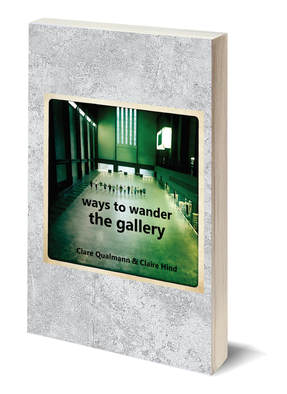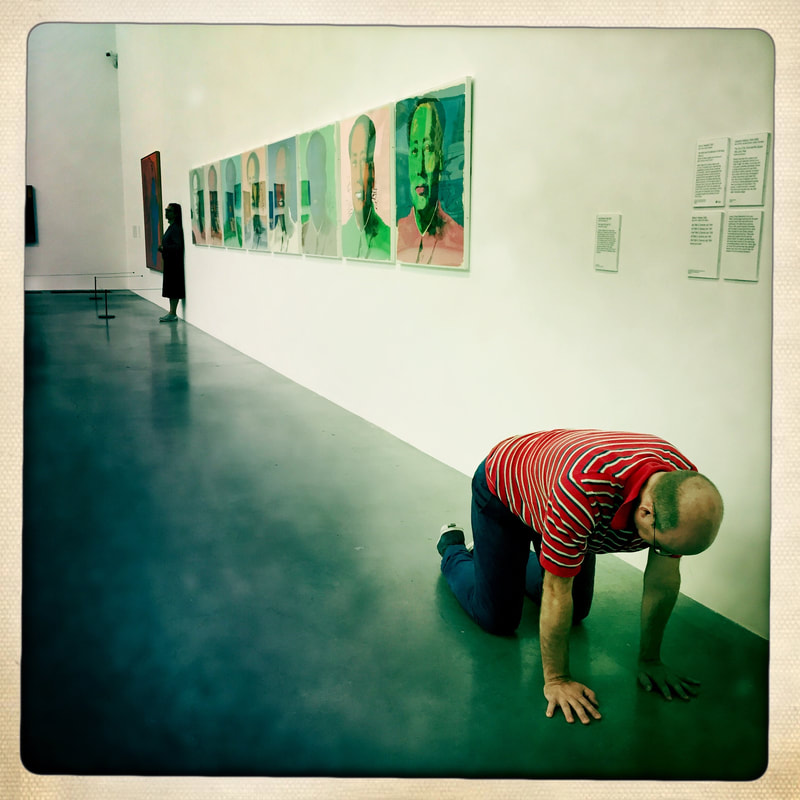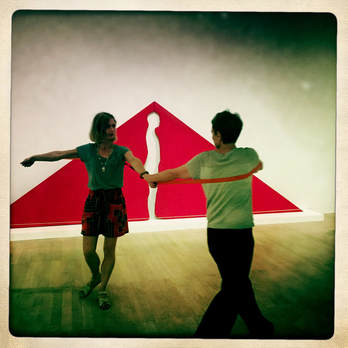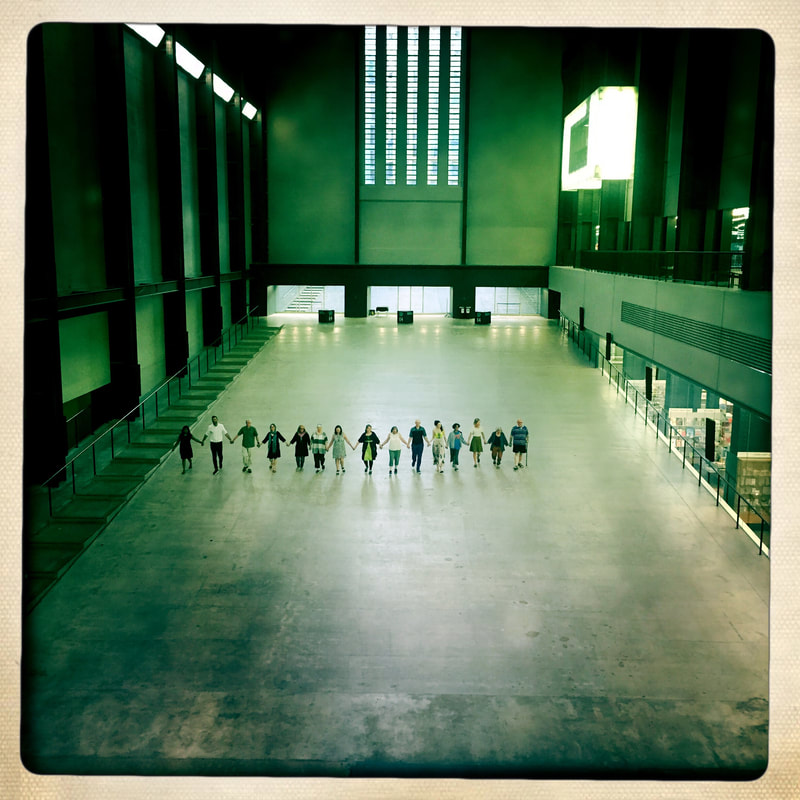Buy the paperback (£10 + p&p):Your copy will normally be despatched within two working days.
Buy the pdf (£10)Click the 'Buy' button below. At checkout, click No postage on ebooks from the dropdown.
After paying, we will send an immediate confirmation and email your ebook file within 24 hours. version: bookmarked pdf
(pdf text cannot be edited, printed or copied - email us if you need this capability.) Publication: November 2018
List Price: £10/$14/€12 Format: ~ Paperback Size: 12.7 x 20.3 cm ISBN: 978-1-911193-51-7 Tags: walking, walking arts, drift, dérive, walking artists network, psychogeography, improvisation |
Ways to Wander the Gallery
Clare Qualmann and Claire Hind 25 intriguing ideas for different ways to walk in and beyond an art gallery - for gallery-goers, walkers, performance artists, students and academics. In the summer of 2017 the editors (Clare Qualmann and Claire Hind ) led a series of weekly workshops at London’s Tate Modern looking at the relationship between walking, art, experimental writing and composition (using their 2015 book Ways to Wander as a starting point). They invited each participant to create a page for this new book. Ways to Wander the Gallery includes the editors' reflections on the workshops, on our relationship to the ‘consumption’ of art in the gallery space and the ‘Wander Scores’ - the artists’ pages which are each an invitation to readers to wander in the gallery and beyond. The book asks you to reconsider your walked relationship with art through the concept of the Wander Score. How playful and embodied can our wandering be in spaces that often make our feet ache? This is an invitation to try 25 different ways to wander in and well beyond the art gallery -- inspired by artists Rebecca Horn, Bruce Nauman, Hito Steyerl, Janet Cardiff, Julie Mehretu and others. Pop the book in your pocket, share it with friends, use it in teaching or in your own workshops, go on a hike with it, and return to the gallery. Read each Wander Score as poetry or make each one a performance. ReadershipThe book is for walkers and anyone who makes, or wants to make, walking art or walk-performances - and for anyone interested in psychogeography, radical walking, drift and dérive.
|
Wander Scores & Contributors
1. Pantoum for Rebecca Horn – Aimée Boutin
2. How to experience Kings Cross Station through Bruce Nauman’s ‘Raw Materials’ – Aimée Boutin
3. A Walk on Another Planet – Olwen Holland. Inspired by the work of Richard Long.
4. Seeing in the dark – Emily Stone - Inspired by Pak Sheung Chuen’s ‘A Travel without Visual Experience’ (2008).
5. Rumours: Using your body – Manjinder Sidhu - Inspired by Janet Cardiff’s ‘Forty Part Motet’.
6. Circular walk: Seeing and touching souvenir – Manjinder Sidhu - Inspired by Julie Mehretu’s ‘Mogamma, a Painting in Four Parts: Part 3’ (2012).
7. An Anarchic Walk – Paul Rochman
8. Alternative Walks around the Periphery of London – Paul Rochman - both Inspired by Cildo Meireles’s ‘Insertions into Ideological Circuits: Coca-Cola Project’ (1970).
9. Why Not? – Kelly Coe
10. Game for Everyone at the Gallery – Kelly Coe - both Inspired by Nam June Paik’s ‘Cage Waves’ (1996).
11. XL – Carolyn Kirkland - Inspired by Janet Cardiff’s ‘Forty Part Motet’.
12. Disguises – Carolyn Kirkland - Inspired by Hito Steyerl’s ‘How Not to Be Seen’.
13. Murmuration – – Kevin Connolly - Inspired by Janet Cardiff’s ‘Forty Part Motet’.
14. Overcoming / Coming Over – Kevin Connolly - Inspired by Rebecca Horn’s ‘Finger Gloves’.
15. NOW-WOW – Alvaro Couso-Gomez - Inspired by Yayoi Kusama´s ‘The Passing Winter’ (2005).
16. Some people run funny – Amy Dakin Harris - Inspired by the Rebecca Horn room.
17. two – Amy Dakin Harris - Inspired by Julie Mehretu’s ‘Mogamma, a Painting in Four Parts: Part 3’ (2012).
18. A walk with restriction of Projective Verse – Elspeth Penfold - Inspired by Rebecca Horn (using the poetry of Larry Eigner as restriction).
19. Listen to the River – Elspeth Penfold - Inspired by Bruce Naumann and Cecilia Vicuña.
20. Spaces of (dis)appearance – Irene Runayker - Inspired by Cildo Meireles’s ‘Insertions into Ideological Circuits: Coca-Cola Project’ (1970).
21. Walking a Trail from Then to Now – Irene Runayker - Inspired by Julie Mehretu’s ‘Mogamma, a Painting in Four Parts: Part 3’ (2012).
22. How to Dance with a Painting – Mary Whalley - Inspired by Julie Mehretu’s ‘Mogamma, a Painting in Four Parts: Part 3’ (2012).
23. Climb the Steps of the Turbine Hall Ramp as a Climber Traverses a Rock Face – Mary Whalley - Inspired by Bruce Nauman’s ‘Raw Materials’ (2004)
24. Walking with a Beard – Blake Morris - Inspired by Henry Scott Tuke’s August Blue (1894).
25. Looking out for Nicholson in St. Ives ~ Cathy Turner - Inspired by Winifred Nicholson.
26 Unfolded Etching #1 – Kris Darby - Inspired by Barnett Newman’s ‘Untitled Etching #1’ (1969).
2. How to experience Kings Cross Station through Bruce Nauman’s ‘Raw Materials’ – Aimée Boutin
3. A Walk on Another Planet – Olwen Holland. Inspired by the work of Richard Long.
4. Seeing in the dark – Emily Stone - Inspired by Pak Sheung Chuen’s ‘A Travel without Visual Experience’ (2008).
5. Rumours: Using your body – Manjinder Sidhu - Inspired by Janet Cardiff’s ‘Forty Part Motet’.
6. Circular walk: Seeing and touching souvenir – Manjinder Sidhu - Inspired by Julie Mehretu’s ‘Mogamma, a Painting in Four Parts: Part 3’ (2012).
7. An Anarchic Walk – Paul Rochman
8. Alternative Walks around the Periphery of London – Paul Rochman - both Inspired by Cildo Meireles’s ‘Insertions into Ideological Circuits: Coca-Cola Project’ (1970).
9. Why Not? – Kelly Coe
10. Game for Everyone at the Gallery – Kelly Coe - both Inspired by Nam June Paik’s ‘Cage Waves’ (1996).
11. XL – Carolyn Kirkland - Inspired by Janet Cardiff’s ‘Forty Part Motet’.
12. Disguises – Carolyn Kirkland - Inspired by Hito Steyerl’s ‘How Not to Be Seen’.
13. Murmuration – – Kevin Connolly - Inspired by Janet Cardiff’s ‘Forty Part Motet’.
14. Overcoming / Coming Over – Kevin Connolly - Inspired by Rebecca Horn’s ‘Finger Gloves’.
15. NOW-WOW – Alvaro Couso-Gomez - Inspired by Yayoi Kusama´s ‘The Passing Winter’ (2005).
16. Some people run funny – Amy Dakin Harris - Inspired by the Rebecca Horn room.
17. two – Amy Dakin Harris - Inspired by Julie Mehretu’s ‘Mogamma, a Painting in Four Parts: Part 3’ (2012).
18. A walk with restriction of Projective Verse – Elspeth Penfold - Inspired by Rebecca Horn (using the poetry of Larry Eigner as restriction).
19. Listen to the River – Elspeth Penfold - Inspired by Bruce Naumann and Cecilia Vicuña.
20. Spaces of (dis)appearance – Irene Runayker - Inspired by Cildo Meireles’s ‘Insertions into Ideological Circuits: Coca-Cola Project’ (1970).
21. Walking a Trail from Then to Now – Irene Runayker - Inspired by Julie Mehretu’s ‘Mogamma, a Painting in Four Parts: Part 3’ (2012).
22. How to Dance with a Painting – Mary Whalley - Inspired by Julie Mehretu’s ‘Mogamma, a Painting in Four Parts: Part 3’ (2012).
23. Climb the Steps of the Turbine Hall Ramp as a Climber Traverses a Rock Face – Mary Whalley - Inspired by Bruce Nauman’s ‘Raw Materials’ (2004)
24. Walking with a Beard – Blake Morris - Inspired by Henry Scott Tuke’s August Blue (1894).
25. Looking out for Nicholson in St. Ives ~ Cathy Turner - Inspired by Winifred Nicholson.
26 Unfolded Etching #1 – Kris Darby - Inspired by Barnett Newman’s ‘Untitled Etching #1’ (1969).
Selected Walking Tactics and Suggestions from the book + Some images from Tate Modern
|
Just a few of the walking tactics and invitations begin as follows:
|




